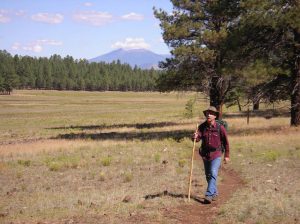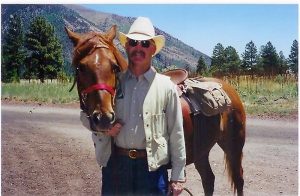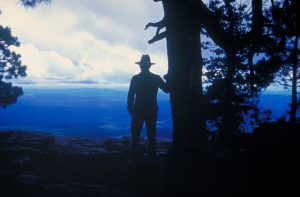In Memoriam: Dale Shewalter

Founder of the Arizona Trail
Dale Shewalter, known as the “Father of the Arizona Trail,” and guiding spirit for the Arizona Trail Association, died on January 10, 2010. Dale passed away, after a many year fight against cancer, in his hometown of Flagstaff, Arizona. Dale had a vision of a continuous path across Arizona, and in 1985 he undertook a journey on foot across the state. Following that experience, Dale began sharing his trail idea throughout Arizona to many people and agencies.

Dale on the trail.
An article in the Arizona Daily Sun noted that Dale “once quit work for a year and put perhaps 60,000 miles on his car in the 1980s to lobby landholding state and federal agencies for their approval.”
The idea quickly took hold and within a few years the Arizona Trail idea was born. Today the 817 mile Arizona Trail is complete and was congressionally designated a National Scenic Trail in 2009. Dale’s positive spirit, sense of cooperation and refusal to give up are still what drives the Arizona Trail Association.
The vision of a continuous border-to-border trail traversing Arizona’s unique landscapes and historic areas had been on the minds of trail users through the years. One individual, however, took the dream and made it a reality. Dale visualized a long-distance trail while on Coronado Peak near the US/Mexico border in the 1970’s.
In 2008 American Trails presented Dale with the State Trail Advocacy Award for Arizona. The citation reads:
“During the summer of 1985, Dale completed scouting the trail route. While walking from the Mexican border to the Utah border, he visualized and tentatively mapped an interlocking route of trail systems traversing the state from south to north. Beginning at the Mexican border, he projected a 750-mile route through desert and mountain corridors all the way to the Utah state line.
The concept of the Arizona Trail was born, offering opportunities for hikers, equestrians, mountain bicyclists, and cross-country skiers to experience the rich diversity Arizona has to offer.
Shewalter, during the next few years, began promoting his vision of a border-to-border trail to key state and federal agencies, service groups, corporations, and individuals. Much interest was evident. He proposed the Arizona Trail concept to the Arizona State Parks Board in 1985, gaining the support and enthusiasm of Larry Mutter, then State Trails Coordinator.
The Arizona Hiking and Equestrian Trails Committee (now known as Arizona State Committee on Trails or ASCOT), the citizen advisory committee to the Arizona State Parks Board, also endorsed the trail concept early on and have since been helping to coordinate the project.”
Also in 2008, Dale was honored by American Trails with the State Trail Worker Award for Arizona. The citation for that award reads:
“As nearly 70 percent of the Arizona Trail is located on national forest lands, the implementation of the Trail made a significant leap forward when, in 1988, Shewalter became the first Arizona Trail Steward Coordinator under the sponsorship of the Kaibab National Forest. This Outdoor Recreation Planner position was made possible through funding from the Kaibab, Coronado, Tonto, and Coconino National Forests.
Dale and Cimarron
On July 1st of that year, seven miles of the proposed 50.5 mile Kaibab Plateau Trail were dedicated and opened to the public as the first segment of the Arizona Trail. The dedication on the North Rim of the Grand Canyon attracted 250 people to the remote site. Upon its completion in 1989 the Kaibab Plateau Trail became the first major leg of the Arizona Trail. In 1994 The Arizona Trail Association, the non-profit organization supporting the development of the Arizona Trail, was established.
Dale has served continuously on the board since its creation, including a stint as President of the Board. He has spoken about the trail to numerous organizations. And he has continued to maintain and build the trail, with long service as a segment steward, as his health has allowed.”
Pam Gluck, Executive Director of American Trails and the former Arizona State Trails Coordinator when Dale’s across Arizona path was in its infancy, provided some of the information on this page. Additional text and photos were provided by Jan Hancock and Phyllis Ralley.
Tribute to the Architect of the Arizona Trail
All great projects begin with the idea of one person gifted with a vision. So it is with the Arizona Trail. Blessed with a love of the land and a reverence for the gifts of nature, Dale Shewalter conceived the plan to build a monument to the unique beauty of the land called Arizona.
This visionary, this leader, molded his idea into a mission. He led with his heart and he inspired the right people to also see his vision become a reality. Hundreds, no thousands, of people around the world caught the excitement of building a trail across Arizona, touching such diverse landscapes that this trail is like no other. Those of us he has touched know his passion, and we share it. In life, and now in death, Dale has passed his hiking staff and the reins of his horse on to those he trusts will continue to cherish this pathway – and help to preserve it for those who follow us.
Dale believes in us. We need to continue his vision and bring all of our talents to keep the Arizona National Scenic Trail among the best of the best. We can offer no greater tribute to Dale than to pledge our hands and our hearts to keep his magnificent project in the annals of this nation’s supreme back country trails.
Jan Hancock
Founding ATA Board Member
Dale Shewalter: Arizona School Teacher with an 800-Mile Shadow
The Arizona Trail lost its founder, Dale Shewalter, on January 10, 2010. Dale died after a long and determined battle with cancer, and after more than 25 years of working to make real his dream of an Arizona Trail.
Born and raised in Illinois, Dale came to Arizona after serving in the Marines in Vietnam. He was a geologist, an avid hiker and horseman, but most of all a teacher for the Flagstaff Unified School District. And at some point, these vocations and avocations coalesced into a crazy idea. Why shouldn’t there be a hiking, biking and equestrian trail that crosses the entire state of Arizona?
“The idea’s not new,” Dale said in an October 1985 article in the Prescott Courier newspaper. “A lot of people have thought about the trail before and other people have walked the length of the state.”
Dale recognized that Arizona’s public lands formed a natural corridor through the state, and existing National Forest and other trails could be used. “A trail system,” he said in the same article, “could link some of these areas with towns in between, so people could enjoy the urban facilities of restaurants and motels, while experiencing Arizona at the pace of a walker.”
To scout the route, Dale walked the State from Nogales to the Utah border, averaging just over 25 miles a day. He gathered much of the intelligence he would later use to promote the Arizona Trail. Soon after, he began traveling the state hawking the idea of an Arizona Trail to state and federal agencies, outdoor enthusiasts, and anyone else who would listen.
One such organization was the Arizona Hiking and Equestrian Trails Committee, a citizen advisory committee to the Arizona State Parks Board that later became the Arizona State Committee on Trails (ASCOT), The committee voted to support the trail, and quickly became an advocate for the Arizona Trail.
The project began to snowball as other individuals, organizations and agencies joined in. Eric Smith heard Dale speak about the Arizona Trail at the Boyce Thompson Arboretum in 1987 and was hooked. “While Dale enjoyed presenting his idea and vision,” Smith recalls, “he also made everyone feel welcome about joining the effort. He knew that it would take many people, and a very long time to succeed in such an effort.”
In 1988, Dale took a year-long leave from teaching to work on the Arizona Trail, and became the first Arizona Trail Steward, a position funded by several national forests. The same year, the first seven miles of the Arizona Trail were dedicated on the Kaibab Plateau.
By the early 1990’s, the development of the Trail was in full swing. Through Dale’s efforts – and those of other individuals and agencies too many to name – the necessary partnerships and relationships were in place to make Dale’s dream of a border-to-border trail a reality. An Intergovernmental Agreement was entered into by state and federal agencies to provide financial and other support for the Arizona Trail project. But one piece of the puzzle remained.
In 1994, the Arizona Trail Association was established. Dale was on the first Board of Directors, served as President for a time in the mid-2000’s, and was a board member for the rest of his life. But more than that, he remained the inspiration for a growing group of people committed to seeing the Arizona Trail to completion and beyond. His messages at the ATA’s annual meetings left people energized, and he continued to set an example by doing everything from trail building to relationship building.
As Dale would later explain, he viewed the Arizona Trail as a collective effort by many. “I am indeed proud of my work to plan, map, and promote the Arizona Trail,” he wrote after a trailhead sign in his honor was dedicated at Flagstaff’s Buffalo Park. “But much more has been needed to bring the Trail to completion. During the past twenty plus years, a great number of highly creative and capable people have devoted their expertise to development of the Trail. I think it safe to estimate that several thousand people have contributed ‘sweat equity’ to the Trail.”
Dave Hicks, current Executive Director of the ATA, was one of those whom Dale inspired. He met Dale at a work event in 2001, when Dale sought him out to talk about the trail and Hicks’ experiences as a through-hiker. “I was flattered that he took the time to talk,” Hicks says. “He was the real deal. No fluff. And a person genuinely interested in other people, especially Arizona Trail hikers.”
Dale’s involvement with the trail continued during his illness. Whenever able, he would participate in a work event, attend a board meeting, or join the celebration at the annual ATA Member Rendezvous at Mormon Lake.
In 2009, Congress named the Arizona Trail a National Scenic Trail. As usual, Dale’s response was not to take credit, but to give thanks. He wrote: “I am personally grateful for all of the devoted people who have worked so hard to bring National Scenic Trail status to our Arizona Trail. The trail will be an adventure for generations of outdoors people to enjoy, and the magic of Arizona’s landscape will be shared with the world.”
The astonishing thing about Dale Shewalter was not that he had a great idea. It was not that he hiked the length of Arizona to map the Trail’s route. It wasn’t that he was a great salesman, managing to get so many people organizations and government agencies to buy in. It wasn’t that he was an inspirational teacher for so many students while remaining an inspirational leader for the Arizona Trail Association. It was that he was all these things.
ATA president Emily Nottingham described it this way: “Lots of people have good ideas, but few have the commitment, vision and persistence to turn them into reality. Few people understand how complex a long distance trail can be to put together, but Dale, even understanding the challenges, did it.”
Dale leaves us with fond memories, certainly inspiration, but more than anything the challenge of completing and preserving the Arizona Trail.
Randy Warner
ATA Board Member
Dale Shewalter once told me a story that illustrates what a charmed life he lived.
He was hiking in a pine forest and passed a spot under a large pine tree that looked like a great place to pitch his tent for the night. He decided, however, to hike a bit further and ultimately found another location to spend the night.
When he returned the next day after a thunderstorm, he found that a tree at the first location had been struck by lightning in the night. The tree had been splintered apart and long daggers the size of fence posts were sticking in the ground all over the area where he had planned to pitch his tent.Dale truly had great fortuity!
Phyllis Ralley
I was working up near the Utah/Arizona border on an AZT work event and had been quite a ways up the mountain with my group. As I came down the mountain later in the day (admiring the nice new trail) I saw a man working on a rock in the path. He wore a large hat and was intent on moving this obstacle from the trail. I stopped to say hello and see if I could help. It was Dale, what a surprise! I didn’t even know he was in the area. We worked on that rock for what seemed like a long time. The more we dug, the bigger the rock got. Finally, I suggested that maybe this rock couldn’t be moved. He looked at me with a big smile and said “We’ll get it”. Since he seemed to enjoy the challenge it inspired me to stay with it too, and we did succeed in removing this obstacle from the trail.
He was sure happy to get it moved. So was I. We talked about that rock for years later. He still remembered it and I remember being inspired by him.
Tom Coulson














 All great projects begin with the idea of one person gifted with a vision. So it is with the Arizona Trail. Blessed with a love of the land and a reverence for the gifts of nature, Dale Shewalter conceived the plan to build a monument to the unique beauty of the land called Arizona.
All great projects begin with the idea of one person gifted with a vision. So it is with the Arizona Trail. Blessed with a love of the land and a reverence for the gifts of nature, Dale Shewalter conceived the plan to build a monument to the unique beauty of the land called Arizona.